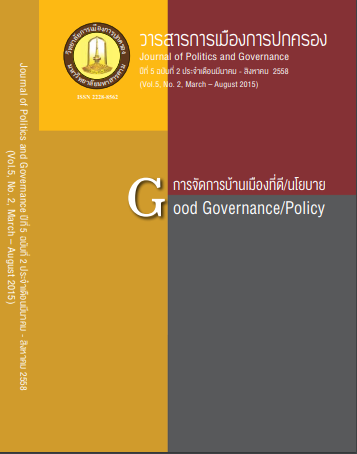What Connectivity Matters in Enhancing Thai Local Governance? Empirical Evaluation of Thai Local Government Survey in 2006
Main Article Content
Abstract
Since the enactment of Act on Tambon Council and Tambon Administrative Organization (TAO) in 1994, 2 decades has passed. It has created almost 7 thousand basic local governments in rural areas from 1995 to 1997. Then, Thai Constitution of 1997 was promulgated, which strengthened autonomy of existing local governments and promoted decentralization. And based on the Decentralization Promotion Act of 1999, massive devolution of duties and responsibilities, financial resources, and personnel was implemented. There are many case studies on local governance in Thailand. Nonetheless, there are few research on local governance based on systematic qualitative analysis. In this paper, we will identify several factors to affect capability of local government, based on the Thai local government survey conducted in 2006 by the Institute of Developing Economies (IDE) of Japan and Faculty of Political Science, Thammasat University. 2 different types of questionnaires were sent to all TAOs and Thesaban (Municipalities) by mailing. And collection ratio was 35%. After identifying important variables, correlation shall be explained between contact frequency as independent valuables and local capability as dependent valuables. Changing connectivity at grassroots level between local governments, field agencies of the central governments and local people shall be analyzed in this paper.
Article Details

This work is licensed under a Creative Commons Attribution-NonCommercial-NoDerivatives 4.0 International License.
References
Japanese
Nagai, Fumio. (2001). Current situation of decentralization in developing countries: the case of Thailand. Institute for International Cooperation, Japan International Cooperation Agency ed. Chio Gyosei to Chiho Bunken [Local Administration and Decentralization]. pp. 47-108. Japan International Cooperation Agency.
Nagai, Fumio. (2006). Democratization and Decentralization in Thailand: Institutional Explanation for the establishment of Tambon Administrative Organizations. Tamada, Yoshifumi and Kimura, Kan eds., Present situation of Modernization and Nationalism, (pp. 103-234). Kyoto: Minerva.
Nagai, Fumio. (2008a). Decentralization Reform: Outcome of 'modernization without rationalization.' Tamada, Yoshifumi and Funatsu Tsuruyo eds., Thailand in Motion: Political and Administrative Changes, 1991-2006, the Institute of Developing Economies, JETRO, pp. 117-158.
Nagai, Fumio. (2008b). 'Political Parties, Elections and Local Politics: case study of decentralization in Thailand.' Takahashi Nobuo, Takenaka Chiharu, and Yamamoto Nobuto eds, Civil Society (Modern Asian Studies vol. 2), Keio University Press, 85-108.
Hashimoto, Takashi 1999a. “Tai ni okeru Chihoseido Kaikaku no Doko to Kadai (1)” (“The Trend of the Reform of the Local government System in Thailand and its Issues I.”) In “Doshisha Hogaku” (“The Law Study of Doshisha University.”), Vol. 50, No.4. pp. 1-38.
________. (1999b). “Tai ni okeru Chihoseido Kaikaku no Doko to Kadai (2-kan)” (“The Trend of the Reform of the Local government System in Thailand and its Issues II”) In “Doshisha Hogaku” (“The Law Study of Doshisha University”), Vol. 50, No.5. pp. 74-143.
Foreign language
Anek Laothammathas. (2000a). Heat Yu thi Thongthin: Panha kanmuang kanpokkhrong Thi Radap Chat ansuep nuang jak Kan pokkhrong Thongthin mai phiang phoo (Why locality is problematic: political and administrative problems at the national level which arise from insufficient local autonomy), Sun Kansuksa lae Phathana kanpokkhrongthongthin, Bangkok: Thammasat University (in Thai).
Anek Laothammathas. (2000-b). Wisaithat Kanpokkhrongthongthin lae Phaen Kankracaiamnat (Local government vision and decentralization plan), Bangkok: Samnakphim Mithimai (in Thai).
Chuwong Chayabut. (1996). Kanphokkhrong Thongthin Thai (Thai Local Administration) Bangkok: Borisat Ngamdii.
Kowit Phuangngam. (2005). Kanpokkhrong Thongthin Thai (Thai Local Government) Bangkok: Winyachon.
Nagai, Fumio, Nakharin Mektrairat and Tsuruyo Funatsu. (2008). Local Government in Thailand-Analysis of the Local Administrative Organization Survey- , Joint Research Survey Series No.147. Chiba: Institute of Developing Economies.
Nagai, Fumio and Kagoya, Kazuhiro. (2011). Local Innovation in Thailand,' Anttiroiko. in Ari-Veikko, Bailey, Stephen, J. & Valkama, Pekka. (eds.) Innovative Trends in Public Governance in Asia, Amsterdam. (pp. 137-150). IOS Press.
Nagai, Fumio and Kagoya, Kazuhiro. (2013). Decentralization and Local Capability in Thailand. A paper presented to the International Symposium on Local Government Survey in Southeast Asia: Comparison among Thailand, the Philippines and Indonesia, January 12 and 13, 2013, Meiji University, Tokyo.
Pathan Suwannamongkhon. (2004). Kanpokkhrong Thongthin Thai nai Boribot khong Rathathammanun haeng Rachaanajakthai Phuthasakarat 2540 (Thai local government in 1997 Thai Constitution) Bangkok: Sukhothai University Press.
Thanet Charoenmuang. (1997). 100 Pi Kanpokkhrong Thongthin Thai Pho.So. 2440-2540(100 Years Thai Local Government 1897-1997), Bangkok: Kopfai.
Woothisan Tanchai. (2001). Kaan Krachaiamnaaj suu kaanpokkhroongthoonthin (Decentralization. Nonthaburi: King Phrachatipok Institute.


